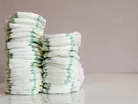Recycled nappies – the next big material in home building?

Disposable diapers have long been considered a huge source of waste.
Because they cannot usually be recycled, the vast majority end up in landfill, where they take hundreds of years to break down.
Globally, every minute, more than 300,000 disposable nappies are sent to landfill, incinerated, or end up in the environment, including the ocean, research from UNEP finds.
But now scientists have discovered a way in which they can be reused safely and constructively – in the building of new housing.
The house that nappies built
Researchers from the University of Kitakyushu in Japan found concrete made with used nappies is just as good as conventional materials.
The study, published in the journal Scientific Reports, reported how up to 8% of the sand in all concrete and mortar required to build a single-storey house (floorplan of 36sqm) could be replaced with used nappies without significantly weakening its strength.
In the experiment, the nappies were first cleaned using chemical additives, and then dried and shredded, before being mixed with concrete. The nappy-infused concrete was then used to build a small house in Indonesia, demonstrating how this type of waste could be diverted from landfills to build more affordable housing in low- and middle-income communities.
Scientists also demonstrated that the mechanical properties and microbial content of disposable diaper concrete, in specific compositions, are identical to conventional concrete.
Adding 1% diaper to concrete enhances internal curating hydration and produces the most robust, durable materials. Furthermore, a mix of up to 5% disposable nappies with concrete had the “maximum strength at 28 days compared to other percentages”.
Good news for construction industry, as sand is dwindling resource
This could be good news for the construction industry, as sand – which is crucial for many building materials, from concrete to plaster to glass – is set to skyrocket in demand over the coming decades due to dwindling reserves.
The second-most used resource on Earth, after water, sand is often dredged from rivers, up along coastlines and mined, with 50 billion tonnes of it thought to be extracted for construction each year. That’s enough to build a nine-storey wall around the planet.
A 2022 UNEP report found that sand extraction is rising around 6% annually, a rate it refers to as “unsustainable”, and calls for the need to develop a circular economy for sand and other building materials.
Recycling construction material from demolition sites (debris) is one way the report finds to reduce the consumption of new sand.
Other waste products are already being used in place of virgin materials, from old tyres in playgrounds to glass in slabs, while the University of Melbourne is experimenting with substituting cement for fly ash, a by-product of burning coal, which is helping to cut down on CO2 emissions.
Supplementing sand with reused nappies is potentially another – if building regulation is changed.
While the concept of mixing nappies with concrete isn’t entirely new, it is the first time the solution has been put to the test in housing – with the scientists producing a low-cost dwelling that complied with Indonesian building standards.
This backs up previous research in 2017, where, in the Indian Journal of Science and Technology reported positive results from a study in Malaysia.
This made use of the super absorbent polymer contained in diapers, which “becomes a gel-like substance” when wet – thereby improving the viscosity of concrete.
- How Industrial Power Connectors Boost Site SafetyConstruction Projects
- IFS and Anthropic: An AI Alliance For Heavy IndustryTechnology & AI
- How Is Amazon's Mass Timber Station Aiding Sustainability?Sustainability & Green Building
- Currie & Brown: How Global Volatility Hits ConstructionConstruction Projects



